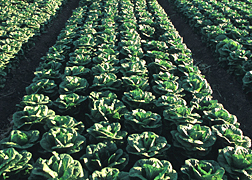|
|
E. coli Gets a Boost from Lettuce Disease
By Kim Kaplan
July 30, 2015
Escherichia coli O157:H7, a bacterium that causes foodborne illness in humans, is more likely to contaminate lettuce when downy mildew is already present, according to U.S. Department of Agriculture (USDA) scientists.
Downy mildew, a lettuce disease caused by the fungus-like water mold Bremia lactucae, is one of the biggest problems that lettuce growers must deal with.
But microbiologist Maria Brandl, with the USDA Agricultural Research Service’s (ARS) Produce Safety and Microbiology Research Unit in Albany, California, has been investigating why so many E. coli O157:H7 outbreaks can be traced back to lettuce fields when E. coli O157:H7 sources are as diverse as undercooked beef, sprouts, raw dairy, shelled walnuts, fruits and vegetables. ARS is USDA’s chief in-house research agency.
Lettuce leaves are actually a harsh place for microbes to survive. But the epidemiological evidence is indisputable about how often lettuce is the source of E. coli O157:H7 contamination.
In earlier research, Brandl found that E. coli O157:H7 preferred cut, injured and younger leaves to undamaged and older ones. Then, she collaborated with ARS geneticist and lettuce breeder Ivan Simko from the Crop Improvement and Protection Research Unit in Salinas, California.
They found that under warm temperature and on wet leaves, E. coli O157:H7 multiplied 1,000-fold more in downy mildew lesions than on healthy lettuce leaf tissue. Even on dry lettuce leaves, where most bacteria struggle to survive, E. coli O157:H7 persisted in greater numbers when downy mildew disease was present.
The researchers also found that E. coli O157:H7 did not grow as well in downy mildew lesions on the lettuce line RH08-0464, bred by Simko and a colleague to be less susceptible to the lettuce disease, as the bacteria did on Triple Threat, a commercial variety that is highly susceptible to downy mildew.
The exact factors that caused less growth of E. coli O157:H7 in the more resistant line still need to be carefully explored. But if a genetic hurdle to E. coli O157:H7 colonization could be bred into commercial lettuce varieties along with downy mildew resistance, it would add a new defensive line to contamination of lettuce, helping farmers to improve the microbial safety of their crop as well as control their number-one plant disease problem.
Read more about this research in the July 2015 issue of AgResearch magazine.

